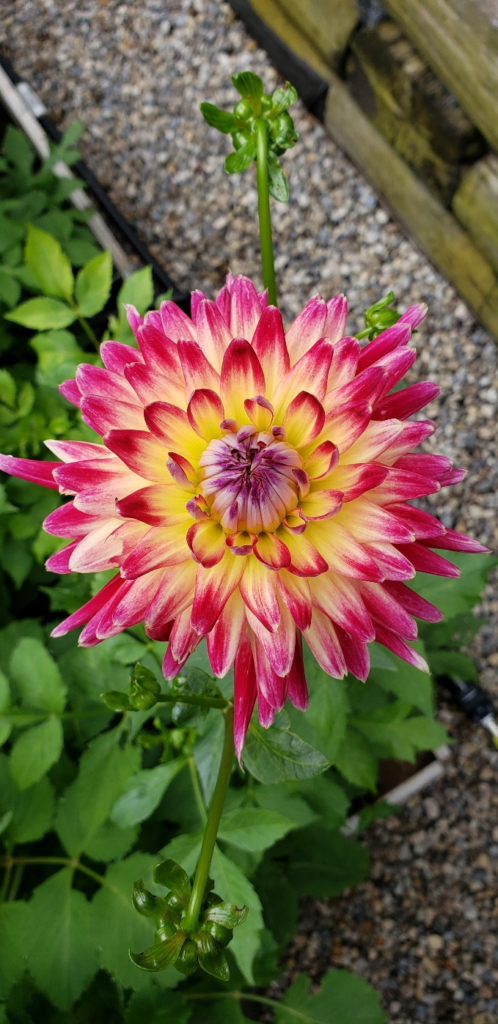Growing flowers is one of the most rewarding sides of gardening. The space to enjoyment ratio is manageable for every garden size when compared to vegetables (hello one pepper growing in my pot.. I guess I won’t starve tonight….), the varieties available is vast, and even a single bloom can bring endless amounts of joy. The other thing we love about growing flowers, is the amount of flower pests is a fraction of those for food. We could write an endless list of pest pressures for vegetables but the list of flower pests is (thankfully!) much smaller.
So! If you love:
gardening,
fresh flowers in your house, or;
gifting flowers to friends
then growing a cut flower garden is for you!
As you read along, we will take you through some of the easiest flowers to grow from seed, or to find at the nursery at an affordable price. Not only do these flowers look amazing, they have a good vase life, come in a variety of shapes and colours to suit your fancy, and the pollinators love them. Finally, we will cover some tips and tricks when setting up your cut flower garden to ensure straight stems that look great in the vase.
By the end of this article, you should have everything you need to start your first cut flower garden, or to improve on your current flower garden!
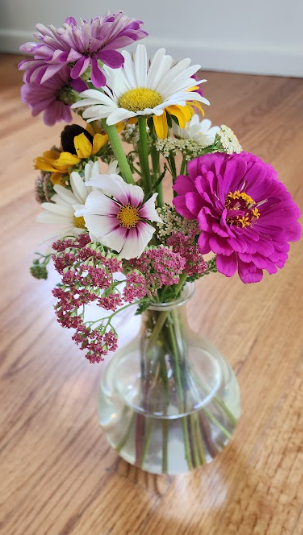
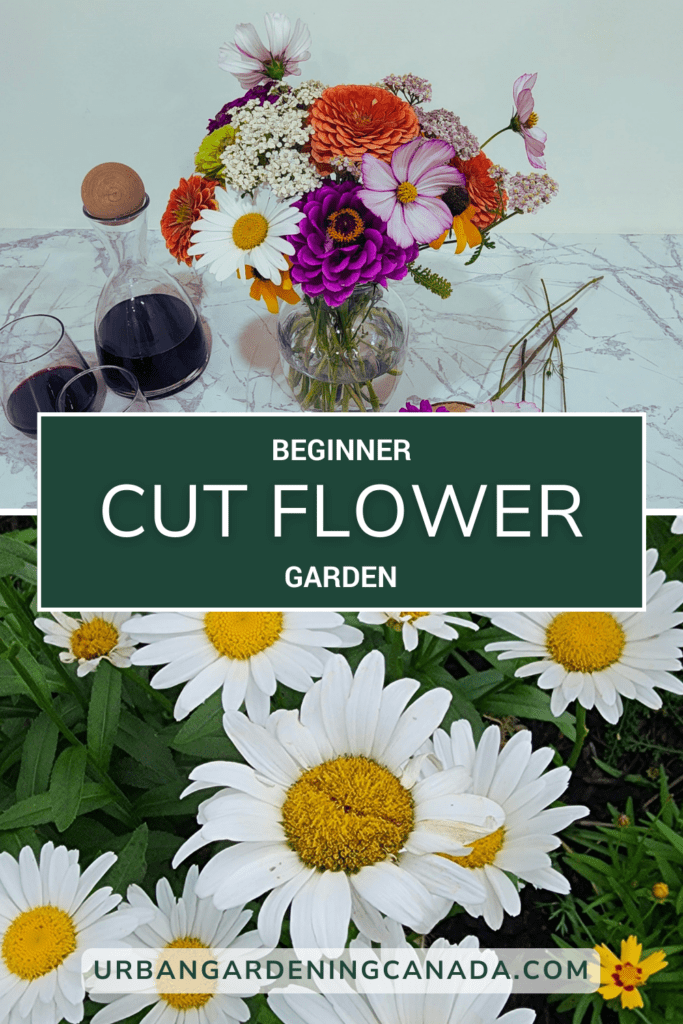
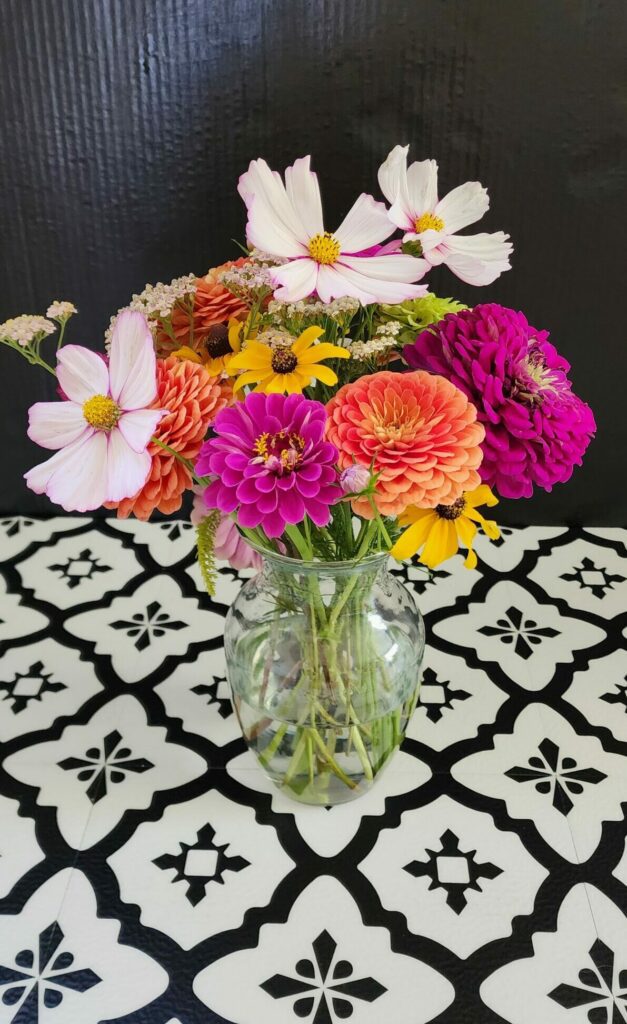
Covered in this article:
Spring Flowers
Spring flowers are the best. After a long, cold, snowy winter, having the chance to have fresh garden flowers in the house is an absolute delight. These three flowers are perennials (come back every year) and look absolutely stunning in a vase.
Peony
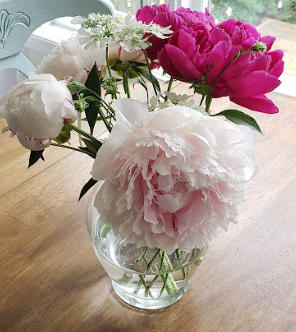
These are our absolute favourite flower. Peonies flower in the spring and come in variations from white, coral, pink to red. You can also find yellow varieties but they tend to be less common.
Peonies can be herbaceous (die back to the ground each winter), hybrid/Itoh (have woody stems that die back near the ground as it is a hybrid of tree peonies and herbaceous) and tree peonies.
An important item to note with peonies is that they take multiple years to establish and they can be very finicky. If you plant them too deep, they usually will not produce flowers. If you move one from one part of your garden to another, they will likely not produce flowers the following year. If you are adding peonies to your garden, put careful consideration in to the location of your garden as you will not want to transplant them in the future, without risk of losing blooms.
What we love about them
- Peonies have the most amazing scent. They will fill the entire room with their perfume.
- You don’t need to cut many of them before your vase is full of beautiful blooms and colour.
- The size of blooms is incredible and look so elegant
How to pick them
Peonies should be cut before they are open. As the bloom begins to open you will see the colour of the bloom, and it will look like a ball on the end of a stem. When you squeeze the bloom, it should feel like you are squeezing a marshmallow. This is the perfect time to cut them, and they will open in the vase.
Pros
- Their scent is incredible
- The colour palettes they come in are absolutely stunning
Cons
- They take multiple years to establish
- Ants love them
- Note: They are completely harmless to the plant, but the ants love the sap that the flowers give out. When picking the flowers, give them a good shake to remove the ants. If you are picking flowers that are fully in bloom, then you will want to give it an upside-down shake outside before bringing them in, however don’t be surprised if you see an ant or two in the house.
Get gardening advice straight to your inbox
Tulips
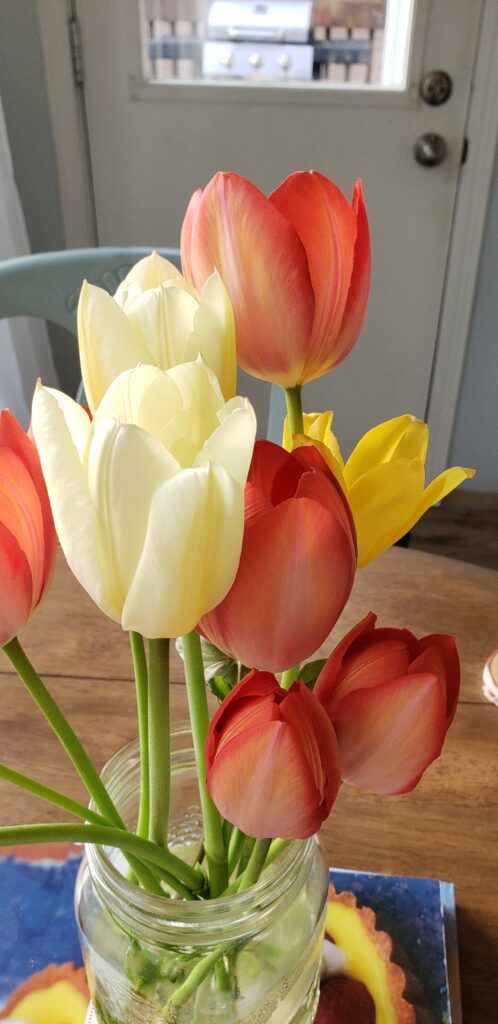
Tulips are a spring bulb that make for beautiful cut flowers. They come in a variety of different shapes and colours. Some flowers are round and ball shape, others are oval (like in the photo). Some have frills and others look like peonies.
Tulips look their best in their first year, and the following years the blooms may be smaller or may not bloom at all. To get beautiful blooms every year, ensure you buy hardy tulips for your zone, and plant them in a more protected area (ie; near your home). If you choose to not cut all of the tulips, those remaining outdoors should have their stem cut down as soon as the flower drops its petals.
What we love about them
• The wide selection that tulips come in means you can find the perfect flower for you
• A vase of tulips can look absolutely stunning and they don’t need any other flowers to make it look beautiful.
How to pick them
Pick tulips when the flower is still closed. As soon as you start seeing colour in the bud, that is the perfect time to cut them. Often times, the stem of tulips will grow substantially in the vase, so you will need to cut them to size every few days.
Pros
• The selection to choose from is incredible.
• They bloom fairly early in spring so you get fresh blooms in the house while it’s still cold out.
Cons
• Squirrels love tulip bulbs and will dig them up any chance they can. You can avoid this by adding some wood ash (ie from a fireplace) over the bulbs before you plant them.
• Squirrels/other animals like to pop the blooms off to access water in the bloom. You can avoid this by leaving water out in a tray for wildlife.
• They bloom best in their first year. By following best care practices, they can bloom well in following years. Additionally, you can plant more bulbs and rotate where you cut each year.
Daffodils
Daffodils are another one of our absolute favourite spring flowers. These are one of the first bulbs to appear in the spring, like a bright ray of sunshine. Daffodils come in a beautiful array of sizes and colours, from white, blush, yellow through to sherbert orange.
Additionally, they grow in different sizes, from small quarter sized blooms to the size of your palm. Some of them even have a beautiful scent. The daffodil in the photo is a single bloom trumpet (which is good for pollinators), but daffodils can come with double blooms that resemble closer to peonies than daffodils!

What we love about them
• They are one of the first to bloom in the season.
• If you leave blooms on the plant and let them go to seed, daffodils naturalize and multiply over the years – which means more flowers!
• Not many pests care for daffodils so they are a stress-free bulb.
How to pick them
Similar to tulips, pick daffodils when the flower bud is still closed but showing its colour. Be aware that daffodils release a toxin from their stem into the water which can kill other flowers (and make you sick if you drank it! Someone on the internet actually did this..). Additionally, they secrete mucilage which can block the stems of other flowers. This will stop the other flowers from taking up water. If you want to mix daffodils with other spring bulbs, cut the daffodils and place them in a vase of water for at least one hour. After the time has passed, you can mix them with the other flowers. However, if you trim the stem, remember to separate them again for the hour or more in a separate vase of water.
Pros
• They are one of the first flowers to bloom
• Animals don’t care for them and tend to leave them alone
• Naturalize fairly quickly giving you more flowers throughout the years
Cons
• Can poison other flowers if you mix them in a vase together too quickly
Summer Flowers
Rudbeckia (Black Eyed Susan)
Rudbeckia are a workhorse in the garden. They are one of the most familiar and reliable flowers. The yellow brings an extra bit of brightness into bouquets, and they come in a multitude of shades from red, orange, brown to yellow. They are like miniature sunflowers, but without the squirrel pressure that sunflowers receive.
What we love about them
• Rudbeckia has a good vase life.
• It flowers prolifically and blooms over the entire summer.
• We absolutely love the earthy tones of the red and brown Rudbeckia. They add a je ne sais quoi to the bouquet. A chefs kiss!
How to pick them
Pick rudbeckia just as the blooms are opening. Cut them the length, or slightly longer than the vase they will be placed in, to encourage the plant to branch out lower and continue to provide long stems. The leaves are easy to pull off the stem, and we usually hold the stem and run our hands down it to pull all the leaves off. Wearing gloves is recommended because the stems can be irritating to your skin.
Pros
• The colour selection is different than most flowers as they come in burgundy and brown rather than the typical purple and pinks
• They flower reliably all summer, and return each year
• They grow on long stems making them easy to cut for a variety of vase sizes
Cons
• They still create pollen after being cut which can make it messy under the vase
• They have a tendency to make the vase water murky
Get gardening advice straight to your inbox
Daisies
What is more iconic than the daisy? White petals with a bright yellow centre, these are a classic perennial flower for any garden. White flowers break up the mash up of colours in a vase, allowing your eye to relax before picking up the next vibrant flower beside it.

What we love about them
• Daisies are another reliable, perennial flower.
• Butterflies enjoy them, while pests tend to avoid them.
• They are drought tolerant which is starting to become an important trait of garden plants as the weather becomes more unpredictable.
• Adding white to a bouquet brings it up another level.
How to pick them
Similar to rudbeckia, pick daisies just as the flower is beginning to open. Cut the stem to the height of the vase.
Pros
• Adding white to a bouquet helps break up the wide array of colours of other flowers
• The long blooming season of daisies means they are always available
Cons
• As they start to die the petals brown and become ugly quickly
Dahlia
Dahlias are beautiful, tender perennial flowers grown from tubers but can also be started from seed. They have a strong cult-like following from many flower growers as they come in such a wide variety of colours, shapes and sizes. Often times, dahlias are the showstopping flower in a bouquet.
What we love about them
• The assortment for dahlias is unbelievable. They come in every colour, shape and size.
• There are single petal flowers, with big yellow centres, and others with so many petals they look like a pom-pom.
• They range in size from a golf ball to a dinnerplate!
How to pick them
Pick the flowers just as they are about to fully open. Cut deep into the plant so that you have nice long stems for your arrangements but also to promote the plant to continue growing long stems.
Pros
• The selection to choose from is incredible.
• They often are the show stopper bloom in a vase
• They have a decent vase life
Cons
• Because they are a tender perennial, the tubers need to be dug up at the end of every season and stored
• Storage is often a problem as the tubers can freeze, rot or mould easily
• They can be expensive to buy
Zinnias
Zinnias are a classic flower for home growers and small flower farmers. They come in a beautiful range of colours (including green!) and have an amazing vase life. Even the butterflies love them, so any blooms you leave out will be enjoyed by pollinators. Our favourite variety to grow for cut flowers is Benary’s Giant
What we love about them
• They bloom all summer long
• They have great stem lengths
• Their size fills in bouquets perfectly
• They come in vibrant colours that are mesmerizing, and antique colours too
How to pick them
Zinnias should be picked when they are fully in bloom. They are ready to be picked when the stem is firm. If you hold the stem 20cm below the bloom, gently shake it and it stays straight and firm, it is ready to be harvested.
Pros
• They come in a beautiful assortment of colours and sizes, including green!
• They bloom for long periods of time when harvested regularly
• They have a great stem length
• They are super easy to grow from seed
Cons
• Their stems are fragile so it is very easy to break them when taking the leaves off the stem
• They tip over in the rain and need to be staked or netted to get straight blooms
Cosmos
Cosmos are the perfect, dainty flower. They are a beautiful, drought resistant annual that fits into any garden. Not only are their blooms beautiful, but the foliage is also very attractive. They come in a fun assortment of colours and shapes, from the double bloom (pictured here) to ones that look like the paper holding a cupcake.
What we love about them
• The dainty look of the cosmo adds a different texture to bouquets
• They come in a beautiful variety of colours; from pink, to white to orange
• They are easy to grow from seed and are drought tolerant
How to pick them
Pick cosmos just as the flower is starting to open. Cut deep in the plant for good stem length. As cosmos progress through the summer they will produce more blooms on shorter stems, so the deeper and more frequently you cut them, the better blooms you will get through the summer.
Pros
• They are drought tolerant
• They are easy to start from seed
• They have a long blooming period
• The colours and textures are unique and add to the bouquet
Cons
• Cosmos need to be staked, as they break from intense rain very easily
• They don’t have the longest vase life
• The stems progressively get shorter as the season continues making it harder to harvest
Yarrow
Yarrow is a multi-purpose flower. It is pollinator-friendly, an herbal plant and works amazingly in bouquets. It is easy to grow from seed and comes back every year. It is hardy to Canada zone 2 which makes it a brilliant plant to add to the garden.

What we love about them
• The texture of yarrow is unlike any flower listed above
• Adding it to your bouquet makes it look professional
• It makes for a nice dry flower
• It comes in beautiful whites, pastels and vibrant pink
How to pick them
Pick yarrow when the blooms are open. It is very easy to pull the leaves off the stem. Cut deep to give a good stem length and to promote long stems for future harvests
Pros
• It is a perennial
• It is easy to grow from seed and will naturalize quickly
• The texture is different so it adds balance to the bouquet
• The white version looks like Baby’s Breath
Cons
• Some people do not like the smell of yarrow
• It can expand its place in the garden quickly and dominate the garden
Want more tips, tricks and garden advice? Sign up to our newsletter!
Tips for setting up your cut flower Garden
- If you plan to grow flowers for cut flower production, rather than as an ornamental garden, you will plant closer than you would for an ornamental garden.
- Be mindful of disease due to low airflow based on the plant spacing. Zinnias are prone to powdery mildew so you will want to keep an eye on the leaves of the plants.
- Be mindful of the height the plants grow to if you plan on mixing cut flowers in to your ornamental gardens.
- Use flower mesh to help keep flowers upright as wind and large rainstorms can tip plants and ruin the stems from staying straight (see photos below)
- An alternative to mesh is to stake every single plant but mesh is easier to set up. You will want to set it up when the plants are young so they can grow through the mesh, vs trying to force plants through mesh later on. Having to height levels of mesh can be very beneficial as some flowers can grow up to 4 feet.
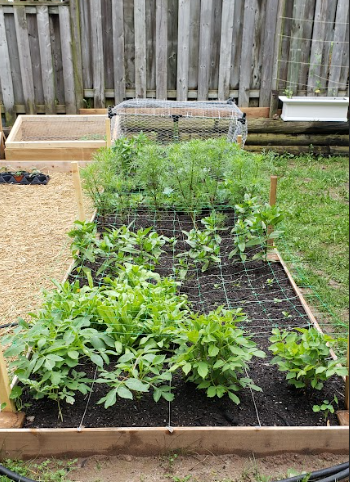
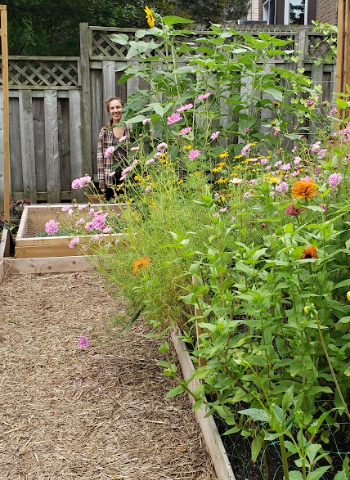
Final Thoughts
As you get more comfortable starting flowers from seed you can expand your arrangements. Playing with different shapes, heights and textures is a great way to add interest to a bouquet. Flowers such as Bells of Ireland and Snapdragons add height, while grasses and Orlaya can add texture.
When choosing the seeds and varieties for your bouquet, look at pictures of bouquets that inspire you and notice the colour palette used. This can help you decide what varieties and colours you will want to grow and incorporate in your garden. Some people love the soft pastels and pinks, while others love the hot, vibrant red and orange.
Finally, spending time looking at bouquets online or at markets will help inspire you on how to build your bouquet or can help troubleshoot what may be missing if you aren’t completely happy.
Making bouquets is an art and each year you will progressively get better. So have patience, but most importantly, have fun!



